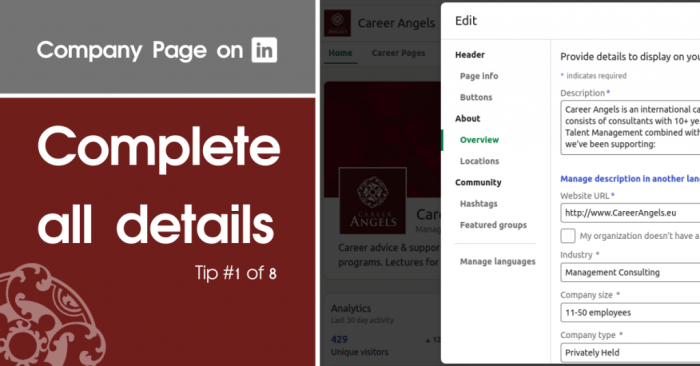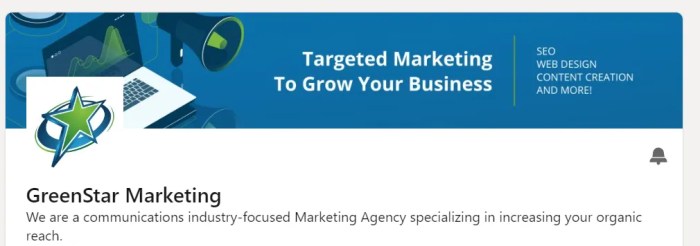6 important LinkedIn company page strategy tips to boost your online presence and connect with potential customers. This guide delves into crafting a compelling company profile, engaging content strategies, building a strong network, optimizing page structure, tracking performance, and adapting to evolving LinkedIn trends. Each tip is crucial for success on the platform.
From designing a captivating company profile that highlights your unique brand to optimizing your page structure for maximum visibility, this comprehensive guide offers practical steps for navigating LinkedIn effectively. Discover how to use content strategically, build meaningful connections, and track key performance indicators to continuously improve your company’s online presence.
Compelling Company Profile
A compelling LinkedIn company page isn’t just about showcasing products; it’s about telling a story. It’s about connecting with potential employees, partners, and customers on a deeper level. A well-crafted profile paints a vivid picture of your company’s identity, mission, and values, inviting viewers to imagine themselves as part of the team or benefiting from your offerings. This detailed approach helps establish trust and fosters a stronger connection with your target audience.A strong LinkedIn company profile effectively communicates the essence of your organization, highlighting its unique attributes and establishing a recognizable brand identity.
This goes beyond a simple list of products or services; it’s about weaving a narrative that resonates with your ideal audience. This is where you establish your company’s voice, character, and mission, making it memorable and attractive to potential partners and employees.
Mission, Values, and Culture
A clear articulation of your company’s mission, values, and culture is paramount. This section should be more than just words; it should reflect the heart and soul of your organization. Use evocative language to paint a picture of your company’s purpose, and the values that drive its actions. For example, instead of simply stating “We value innovation,” describe how innovation manifests in your daily operations, highlighting specific examples or initiatives.
This tangible demonstration of values makes the company profile more relatable and authentic. Use the company’s core values to guide the language and tone of the entire profile.
Company History and Achievements
Highlighting the company’s journey is crucial for building credibility and demonstrating longevity. Don’t just list dates and milestones; weave a narrative that showcases the evolution of the company, highlighting key turning points and significant achievements. Include quantifiable results whenever possible. For instance, instead of “Improved customer satisfaction,” mention “Increased customer satisfaction scores by 15% in the past year.” Showcase your company’s evolution through a compelling story, demonstrating how it has adapted and thrived over time.
Product/Service Introduction
Presenting your products or services effectively is vital. Avoid a dry, technical description. Instead, focus on the benefits they offer to customers. Use compelling language that emphasizes the value proposition and how your offerings solve problems or improve lives. Frame each product or service as a solution to a specific customer need, and explain how it surpasses competitors’ offerings.
For example, if you offer software, explain how it streamlines workflows and boosts efficiency, providing concrete data points wherever possible.
Team and Expertise
Showcasing your team and their expertise builds trust and demonstrates your organization’s capabilities. There are several approaches to achieve this:
- Highlight key personnel: Feature team members who embody the company’s values and represent specific areas of expertise. Include a brief bio that showcases their unique skills and contributions to the company’s success.
- Showcase team expertise: Create individual team member profiles within your LinkedIn company page. Include details about their background, skills, and projects to build a comprehensive picture of your team’s expertise. A team member specializing in marketing could be highlighted with projects showcasing successful campaigns.
- Showcase collective expertise: Highlight specific teams or departments within the company that represent specific areas of expertise. This approach can build a more comprehensive view of your organization’s capabilities. A dedicated research and development team, for instance, could be showcased with details of their innovations and breakthroughs.
Unique Company Brand Voice
Crafting a unique brand voice for your LinkedIn company page is essential for creating a consistent and memorable identity. Your brand voice should reflect your company’s personality and values. It should resonate with your target audience, making your company more approachable and relatable. This is achieved through careful selection of language, tone, and style. For example, a tech startup might use a more energetic and innovative voice, while a financial institution might adopt a more professional and trustworthy tone.
Knowing the 6 crucial LinkedIn company page strategies is key to standing out. But how do you actually connect with those potential professional services buyers? Understanding their needs and pain points, as outlined in how to reach professional services buyers1 , is just as important. This targeted approach, combined with engaging content and a clear call to action, is what truly makes a LinkedIn company page successful.
Consistency in brand voice across all platforms is critical. A clear brand voice establishes a consistent image and message, enhancing the overall effectiveness of your LinkedIn presence.
Engaging Content Strategy
A compelling company profile is just the first step. To truly connect with your LinkedIn audience and drive engagement, you need a robust content strategy. This involves more than just posting updates; it’s about crafting a consistent flow of valuable information that resonates with your target demographic. This strategy should attract attention, encourage interaction, and ultimately, lead to meaningful connections.A well-defined content strategy ensures your LinkedIn presence isn’t just a one-way broadcast, but a dynamic platform for dialogue and relationship building.
Looking for ways to supercharge your LinkedIn company page? Six key strategies are crucial for visibility and engagement. From optimizing your profile to crafting compelling content, these strategies are essential. But, if you’re aiming for real impact, consider how principles like those in “the 7 habits of highly effective people is a blueprint for the positionless marketer” ( the 7 habits of highly effective people is a blueprint for the positionless marketer ) can guide your approach.
Ultimately, these six strategies, combined with a mindset focused on genuine connection and value, will unlock your LinkedIn company page’s full potential.
By understanding your audience’s needs and preferences, you can tailor your content to foster engagement, increase visibility, and position your company as a thought leader in your industry.
Content Variety and Format
A diverse content mix keeps your LinkedIn feed interesting and encourages engagement. Don’t rely solely on text updates. Incorporate various formats like articles, videos, infographics, and polls to cater to different learning styles and preferences. Visual content, in particular, tends to grab attention and drive higher engagement rates.
Scheduling and Optimization
Strategic scheduling is crucial for maximizing your content’s reach. Understanding your audience’s online activity patterns will help you tailor your posting schedule for optimal impact. Analyzing engagement data from previous posts can reveal trends and identify peak times for interaction. Experiment with different posting schedules to see what resonates best with your audience.
Different Content Posting Schedules
Experimentation with various posting schedules can significantly impact engagement. Consider a consistent daily posting schedule, or alternate with a few posts per week. A daily approach can keep your brand top-of-mind, while a less frequent schedule allows for more in-depth, high-quality content. For instance, a daily post could include short updates and engaging questions, while weekly posts could feature insightful articles or industry analyses.
Monitor the results and adjust your schedule based on audience response. Tracking metrics like impressions, clicks, and comments will help you fine-tune your approach.
Visual Content Strategy
Visual content is a powerful tool for capturing attention and conveying information effectively on LinkedIn. High-quality images and videos can significantly increase engagement and memorability. Infographics, for example, can present complex data in a digestible and visually appealing format. Videos, whether short, animated explainer videos or longer, more in-depth discussions, can offer an engaging alternative to text-based content.
Consider the message you want to convey and select the visual format that best supports it. Always ensure visual elements are relevant to your brand and complement your message. Visuals should not just be decorative, but integral to conveying information.
Building a Strong Network
LinkedIn isn’t just a platform for showcasing your professional profile; it’s a powerful tool for forging connections and expanding your network. A robust LinkedIn network translates into increased visibility, potential collaborations, and access to valuable opportunities. Building this network requires proactive engagement and a focus on meaningful relationships, rather than just accumulating connections.Actively engaging with the LinkedIn community, connecting with potential customers and partners, and nurturing existing relationships are crucial for success.
Identifying and targeting key individuals for connections, combined with strategic outreach methods, can significantly boost your company’s visibility and generate leads.
Strategies for Active Engagement
A strong LinkedIn presence requires consistent engagement with the platform’s features. This involves more than simply posting updates; it demands proactive participation in conversations and interactions with other members. Participating in industry discussions, sharing relevant content, and actively commenting on posts from others demonstrate genuine interest and build rapport.
- Connect with Potential Customers and Partners: Identify individuals and companies that align with your target audience and business goals. Research their profiles, understand their needs and interests, and craft personalized connection requests that highlight the value you can offer. Avoid generic messages. Instead, mention specific projects or posts that sparked your interest. This shows you’ve taken the time to understand them and their work.
- Identify and Target Key Individuals: Utilize LinkedIn’s advanced search filters to find individuals with specific job titles, industries, or connections that align with your target market. Focus on individuals who hold influential positions or have demonstrated expertise in your field. Researching their work history and current activities can provide valuable insights and tailor your outreach to their specific interests.
- Effective Outreach Methods: When reaching out to potential clients or collaborators, personalize your messages. Instead of generic requests, mention specific projects, posts, or shared connections that sparked your interest. Highlight the value you can offer and how your company can help them achieve their goals. Avoid overly promotional messages. Focus on building a relationship first, then subtly introduce your value proposition.
Maintaining Meaningful Relationships
Nurturing existing connections is just as important as cultivating new ones. Regular interaction, thought-provoking conversations, and providing value through insightful comments and shared content are essential to maintaining these relationships. This demonstrates your commitment to building genuine connections, rather than simply seeking transactional interactions.
- Value-Driven Interactions: Engage in conversations that go beyond simple “likes” or comments. Ask insightful questions, share relevant articles, or offer your expertise to add value to the discussion. This fosters trust and strengthens relationships over time.
- Personalized Communication: Remember individual preferences and tailor your interactions accordingly. Address connections by name and reference previous conversations to show you’re paying attention and value their contributions. Personalization fosters stronger bonds and demonstrates your commitment to individual relationships.
Leveraging LinkedIn Groups and Discussions
LinkedIn groups and discussions provide valuable platforms for increasing visibility and engaging with a wider audience. Active participation in relevant groups demonstrates your expertise and allows you to connect with professionals who share your interests. Sharing valuable insights and participating in thoughtful discussions can position your company as a leader in your industry.
- Strategic Group Participation: Join groups that align with your industry and target audience. Actively participate in discussions, offering insightful contributions and engaging with other members. This helps establish your company’s expertise and build relationships with potential customers and partners.
- Thought Leadership: Share your expertise by posting valuable content, such as articles, case studies, or industry insights. This can position your company as a thought leader and attract new connections interested in your work.
Optimizing Company Page Structure
A compelling LinkedIn company page goes beyond a static profile; it’s a dynamic hub for engagement and conversion. A well-structured page is easily navigable, visually appealing, and encourages interaction. This section dives into the crucial elements for optimizing your company page, focusing on a user-friendly experience that fosters connection and drives desired outcomes.A well-designed company page acts as a storefront, attracting potential customers, partners, and employees.
By strategically utilizing design elements, calls to action, and clear information architecture, your company page can become a powerful tool for growth. Optimizing this crucial aspect of your online presence can significantly impact your overall reach and impact.
Visual Appeal and User Friendliness
Creating a visually appealing and user-friendly LinkedIn company page is essential for capturing attention and encouraging engagement. The page’s aesthetic should reflect your company’s brand identity, while the layout should prioritize clarity and ease of navigation. High-quality images, consistent branding, and clear typography contribute to a professional and engaging visual experience.
Effective Calls to Action (CTAs)
Strategic calls to action are critical for driving conversions on your LinkedIn company page. CTAs should be clear, concise, and compelling, guiding visitors toward desired actions. Examples include encouraging visitors to learn more about a product, download a resource, or connect with your team. Using compelling language and a clear visual cue (e.g., a button) can significantly increase the likelihood of a successful conversion.
Looking to boost your LinkedIn company page presence? Six key strategies can make a real difference. From optimizing your profile for searchability to engaging with your audience, these strategies are essential. Want to make your content more compelling? Consider these 4 tips to incorporate visual content into your content marketing strategy, like using high-quality images and videos to grab attention 4 tips to incorporate visual content into your content marketing strategy.
Ultimately, incorporating these visual elements can dramatically enhance your LinkedIn presence, leading to more engagement and better brand recognition. So, remember those 6 important LinkedIn company page strategy tips!
Organizing Company Information for Easy Navigation
A well-structured page with easy navigation is crucial for user experience. This includes clear sections, concise descriptions, and relevant links. Use bullet points, headings, and subheadings to organize information logically. Use s to enhance search engine optimization (). This structured approach helps visitors quickly find the information they need.
Creating a Clear and Concise Page Layout
A well-organized page layout is vital for a positive user experience. This involves using headings and subheadings, bullet points, and whitespace to create a visually appealing and easily scannable format. Using a consistent color scheme and font style throughout the page reinforces your brand identity. Including relevant visuals such as images and videos enhances the content’s impact.
Best Practices for Company Page Optimization
| Aspect | Best Practice |
|---|---|
| Visuals | Use high-quality, professional images and videos that align with your brand. |
| Content | Create engaging, informative, and shareable content that resonates with your target audience. |
| Calls to Action (CTAs) | Include clear and compelling CTAs that encourage visitors to take desired actions. |
| Navigation | Organize your page into logical sections and use clear, concise headings and subheadings. |
| Information | Ensure accurate and up-to-date company information is easily accessible. |
| Branding | Maintain consistent branding elements throughout the page. |
Tracking and Analyzing Performance

LinkedIn company pages are powerful tools, but their effectiveness hinges on understanding how your audience interacts with them. Without careful monitoring and analysis, you’re flying blind, unable to optimize your strategy and maximize your impact. This crucial step involves tracking key metrics and using data to refine your approach.Effective LinkedIn company page management requires constant evaluation and adaptation.
Data-driven decisions lead to better content, increased engagement, and ultimately, more meaningful connections with your target audience. This section focuses on the vital process of tracking and analyzing your performance.
Key Performance Indicators (KPIs) for LinkedIn Company Pages
Understanding which metrics to track is crucial for success. The most important KPIs to monitor include engagement rates, reach, impressions, and click-through rates. These provide a comprehensive picture of how your content is resonating with your audience.
- Engagement Rate: This metric measures the level of interaction your content generates, including likes, comments, shares, and reactions. A higher engagement rate signifies that your content is appealing and encourages interaction.
- Reach: This reflects the number of unique individuals who viewed your content. A wider reach indicates broader exposure and potential for new connections.
- Impressions: This counts the total number of times your content was displayed, whether or not it was viewed. High impressions indicate your content is visible to a large audience.
- Click-Through Rate (CTR): This KPI measures the percentage of people who saw your content and clicked on it. A high CTR suggests that your content is compelling enough to drive action.
Monitoring and Analyzing Engagement Rates, Reach, and Impressions
Tracking these metrics is not enough; you need to analyzewhy* they are high or low. Tools like LinkedIn’s analytics dashboard provide valuable insights into audience demographics, content performance, and more. Careful examination of these factors reveals trends and patterns that guide future content creation and scheduling.
- Identify Top-Performing Content: Analyze which types of content—articles, videos, images, or other formats—generate the highest engagement. This insight can help you tailor future content strategies.
- Audience Segmentation: LinkedIn analytics often allow you to segment your audience based on factors like industry, job title, or location. Understanding these segments helps you tailor content to specific needs and interests.
- Time of Posting: Analyze when your audience is most active on LinkedIn. This data can help optimize posting times for maximum visibility and engagement.
Evaluating Content Effectiveness, 6 important linkedin company page strategy tips
Analyzing different content types allows you to understand what resonates with your target audience. You can compare the performance of various posts, such as articles, images, videos, and carousel posts, to identify the most effective formats.
- Content Type Analysis: Track the performance of different content types to identify your most effective approach. For instance, videos might have a higher engagement rate than written articles.
- Content Themes: Analyze which content themes resonate most with your audience. This allows you to create future content around topics that generate interest.
- Call-to-Actions (CTAs): Evaluate the effectiveness of different CTAs to understand what motivates your audience to take action. A clear and compelling CTA can significantly increase engagement.
Using Analytics to Adjust Strategies
Data analysis should be a continuous cycle. Identify areas for improvement based on the data and adapt your content strategy accordingly. For instance, if certain types of posts consistently underperform, adjust your content mix to focus on more successful formats.
- Identify Trends: Regularly review trends to anticipate audience needs and adapt your content strategy accordingly.
- A/B Testing: Experiment with different content formats, headlines, and calls-to-action to identify what resonates best with your audience. A/B testing allows you to fine-tune your strategy iteratively.
- Regular Reporting: Create regular reports to track progress, highlight successes, and identify areas for improvement. This will inform future strategies.
Comparison of Analytics Tools
Different tools offer varying features and functionalities. Consider factors like price, features, and ease of use when selecting a tool.
| Tool | Features | Pricing | Ease of Use |
|---|---|---|---|
| LinkedIn Analytics | Comprehensive insights directly from LinkedIn | Free | High |
| Google Analytics | Broader tracking, integration with other platforms | Free (basic), paid (advanced) | Medium |
| Sprout Social | Social media management, analytics, and reporting | Paid | Medium |
| Hootsuite | Social media management, analytics, and reporting | Paid | Medium |
Adapting to Trends and Changes
Staying relevant on LinkedIn requires more than just posting. A successful company page strategy adapts to the ever-evolving platform. Understanding and proactively responding to current and emerging trends is crucial for maximizing reach and engagement. This involves not just keeping up with new features, but also adjusting your content and approach to align with evolving best practices.Constantly evolving algorithms and user behavior mean that strategies that worked well in the past might need refinement.
Companies must be agile and responsive to these changes, optimizing their approach to maximize their impact on the platform. Adapting to trends and changes isn’t just about staying current; it’s about staying ahead of the curve.
Understanding LinkedIn’s Evolving Features
LinkedIn frequently introduces new features and updates to its platform. These changes can significantly impact how your content is seen and how your company page performs. Understanding these changes is vital to adapting your strategy effectively. For example, the introduction of new post formats, such as polls or video features, can influence user engagement and interaction.
Adapting Content and Strategies
Companies can adapt their content strategies by leveraging new features. For instance, if LinkedIn introduces a new video format, companies can create and share engaging video content to capitalize on the increased visibility. Similarly, if LinkedIn highlights specific content formats, companies should adjust their posting strategy to include those formats. This responsiveness allows for better alignment with current best practices and user preferences.
Adapting to trends means not only incorporating new features but also ensuring your content resonates with the platform’s current audience.
Staying Informed about Emerging Trends and Technologies
Staying abreast of emerging trends and technologies on LinkedIn is paramount for maintaining a successful presence. Following industry blogs, attending webinars, and engaging with thought leaders can provide valuable insights. Following influencers and industry experts can provide valuable insights into how other companies are adapting to trends and new technologies. Utilizing LinkedIn’s own resources, such as its news and articles, is also beneficial.
LinkedIn itself often publishes articles about trends and best practices.
Evaluating New Features and their Impact
Evaluating new features and their impact on the company page is a key part of adapting to change. This includes monitoring how engagement metrics change after implementing a new feature. Tracking analytics such as click-through rates, impressions, and comments will help determine the effectiveness of the new feature. Testing different approaches with A/B testing is a valuable tool for gauging which strategies resonate best with your audience.
Experimenting with new features is an important part of the evaluation process.
Resources for Staying Informed about LinkedIn Updates
- LinkedIn’s official Help Center: This provides detailed information on platform updates and features.
- LinkedIn’s News and Articles: LinkedIn often publishes articles discussing industry trends and platform changes.
- Industry blogs and publications: Following relevant blogs and publications dedicated to social media marketing and business development can help keep you informed.
- Social media marketing experts: Engaging with social media experts on LinkedIn or other platforms can provide insights into best practices and emerging trends.
- Online forums and communities: Participating in online forums and communities related to LinkedIn marketing can offer valuable insights and discussions.
Final Thoughts: 6 Important Linkedin Company Page Strategy Tips

In conclusion, implementing these 6 important LinkedIn company page strategy tips can significantly impact your company’s online visibility and engagement. By crafting a compelling profile, developing an engaging content strategy, building a strong network, optimizing your page structure, tracking performance, and adapting to trends, you’ll be well-positioned to connect with your target audience and achieve your business objectives on LinkedIn.
Remember consistency and adaptation are key to success.






